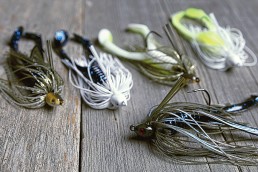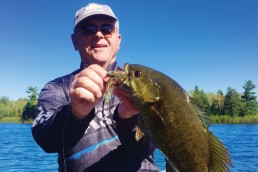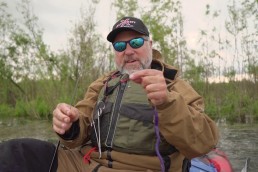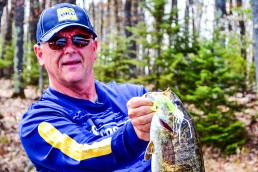Swim Jigs for Bass: One Bait, a Whole Bag of Tricks
SHARE THIS POST
by Joe Bucher
I fully admit that I’ve become addicted to swim jigs and their bass-catching abilities in a wide range of conditions. In fact, I now find myself using the swim jig in place of many longtime favorites such as a spinnerbait, a shallow-running crankbait or even weedless, rigged soft plastics. There are simply so many things you can do with this jig and the bass are highly attracted to it. Plus, using it is so incredibly versatile.
For example, the swim jig is equally effective when cast over debris-free bottoms as well as the insides of the thickest jungles of cover. It will catch plenty of fish by simply casting it out and straight-retrieving it or when doing a hop-and-drop on the bottom. It even catches fish with no retrieve at all—casting it out over a high-potential spot and leaving it in place.
In a nutshell, this jig design is absolutely deadly and I highly recommend them.
What makes a swim jig special is its unique design. These jigs typically have the line tie positioned more right off the nose of the jig. A line tie positioned off the nose promotes a more horizontal travel instead of a strong dropping action. The better swim jigs on the market also have a sleek, minnow head-shaped design, further enhancing its ability to slither through grass and brush. Traditional bass jigs tend to have line ties coming off the jig head at more of an exaggerated angle and have fatter head configurations, which promote a vertical downward motion.
Typical weights for these tend to be on the lighter side. In fact, most bass jig manufacturers don’t even offer a swim jig over 1/4 ounce. But I’ve found many instances where the heavier weights are definitely superior, so I encourage you to seek out manufacturers that offer these heavier versions. Wind, waves and current all beg for a 5/16- to 3/8-ounce version. Additionally, you can speed up or slow down the drop of these heavier jig weights by attaching different styles of grub trailers. For example, a fat, twin-tail grub body with paddle feet is sure to be far more buoyant and water resistant than a skinny, single, curly-tail style. The same swim jig will sink much slower with the fat twin-tail paddle grub. If you need a faster drop, pick a skinny trailer.
Are you enjoying this post?
You can be among the first to get the latest info on where to go, what to use and how to use it!
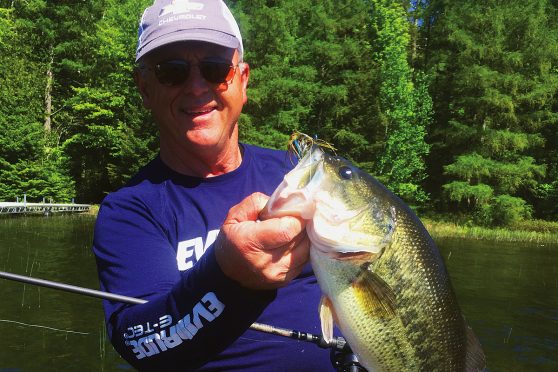
High-quality thin wire hooks with a thin, flexible brush guard are vital for connecting quickly with striking fish. A beefy hook combined with a thick brush guard—common to many traditional bass jigs—simply misses too many fish. Heavy-duty jigs of this more traditional nature were meant for flippin’ and pitchin’ into thick cover. Strikes are more apt to occur during a pause, which allows the angler time to “load up” before setting the hook. Of course, the heavy-duty hook is necessary in order to pull a big bass out of thick jungles. Swim-jig strikes are more apt to occur as the jig travels forward and the bass swipe at it. A thin brush guard with a needle-sharp thin wire hook locks on to these swipers, while a thicker guard with a beefy hook surely misses these opportunities.
I tend to throw swim jigs on the same baitcasting gear I would normally fish a spinnerbait: a medium- heavy-action 6 1/2-foot baitcasting rod, small baitcasting reel and 20-pound-test braided line. Speaking of the spinnerbait, I essentially look at a swim jig as a spinnerbait without the spinner. With that in mind, I generally fish a swim jig over, around, and through cover that is normally considered spinnerbait terrain. However, unlike a spinnerbait, a swim jig is equally effective with a stop-and-go, hop-n-drop retrieve, as well as when you just leave it to sit in place alongside a high-potential piece of cover. The swim jig also can go through said cover that a revolving spinner blade can’t. This includes thick grass, emergent cattails and all kinds of surface vegetation. You have to experiment on any given trip to see where the bass are located and then rig up a jig to pitch to them.
Anglers like high-vis. color patterns on swim jigs like spinnerbait colors of white, chartreuse and similar hues. Loud patterns can be particularly good over shallow obstacles in darker water and they allow you to sight-fish the jig. You can easily keep tabs on the jig throughout the retrieve with brighter hues. When bass are aggressively chasing baitfish, these brighter patterns are superb. But I have found dark swim jigs can out-fish the brighter patterns when bass are on a strong crawdad bite. This is when brown, dark green and a touch of orange are tough to beat. When the bass seem to be chasing but are not committing to the brighter- patterned baits, go darker.
Finally, success with swim jigs often centers on your choice of an accompanying trailer. Like I stated earlier, fatter-bodied trailers are bound to slow the drop speed; thin-bodied grubs promote faster descents. I tend to favor twin-tail grubs for a lot of my swim jigging because they keep the overall profile of the bait very compact, improving solid hook-ups with big bass. And experiment with different actions, colors and combos until you hit on a winner. Above all, make certain you add this incredible lure to your bass-fishing arsenal. MWO

MWO
SHARE THIS POST
Did you enjoy this post?
You can be among the first to get the latest info on where to go, what to use and how to use it!
Dave Mull
Dave Mull of Paw Paw, Mich. has spent his career communicating the outdoors experience and runs Inner Viking Media. He enjoys kayak fishing for anything that swims in the lakes and rivers of the Midwest and beyond, and even uses his MirroCraft, from time to time. Available for seminars.
